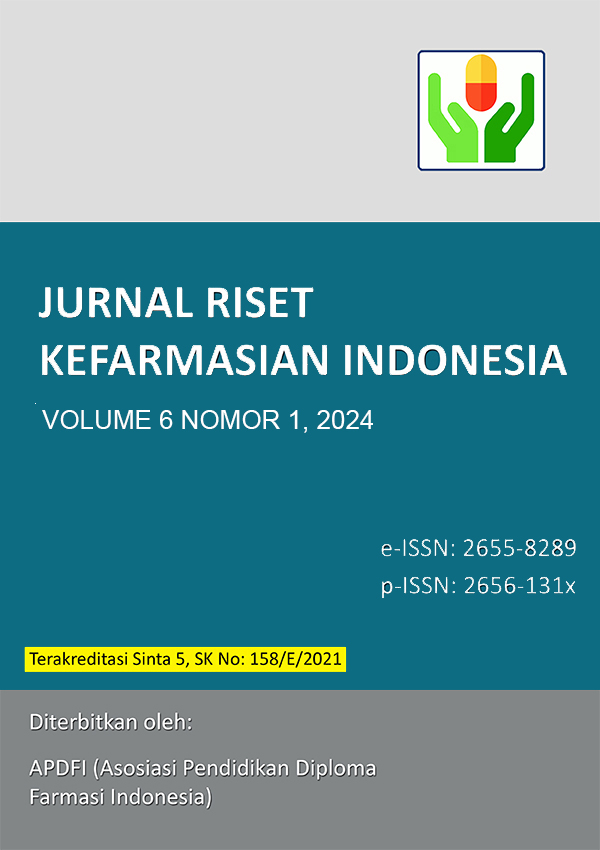KARAKTERISASI DAN SKRINING FITOKIMIA BUAH LABU KUNING (Cucurbita moschata Duch.)
DOI:
https://doi.org/10.33759/jrki.v6i1.420Keywords:
Cucurbita moschata Duch, simplisia, ekstrak, karakterisasiAbstract
Pumpkin (Cucurbita moschata Duch.) is one of the plants that contain carotenoids, water-soluble vitamins, phenolics, flavonoids polysaccharides, mineral salts. Pumpkin is a vegetable that has many health benefits. Empirically, the pulp is used to treat diabetes, hypertension, tumors, immunomodulators and antibacterials. The benefits of a natural material with medicinal properties need to be proven scientifically through research. As a first step, characterization of simplisia and ethanol extract of pumpkin fruit and secondary metabolite content were carried out. This study aims to determine the characteristics of simplisia and pumpkin fruit flesh extract and its secondary metabolite content. Characterization includes specific and non-specific parameters. Pumpkin fruit was extracted by maceration with 70% ethanol and obtained an extract yield of 29.68%. Specific characterization results include organoleptic observations in the form of thick blackish brown extract, bitter taste, and distinctive smell. Organoleptic simplicia simplicial piece, odorless, yellow, and bitter taste. The average level of soluble compounds in water extract is 47.33% and simplisia is 22%, while the average soluble compound in ethanol extract is 51.77% and simplisia is 31.33%. Non-specific characterization results include the average total ash content of extracts of 6.52% and simplisia of 8.33%, acid insoluble ash content test averaged 0.31% extracts and 0.22% simplisia. The average water content was 17.55%. The average specific gravity of the extract was 1.02 g/mL and the results of the total microbial contamination in the extract were 4.2 × 103 colonies/g and simplisia were 4.6 x 103 and the yeast mold number in the extract was 1.3 × 102 colonies/g and simplisia was 1.7 × 102 colonies/g. Pumpkin fruit extract and simplisia contain secondary metabolites including alkaloids, flavonoids, saponins, and terpenoids.
Downloads
References
Badan POM RI. (2014). Peraturan Kepala Badan Pengawas Obat dan Makanan Republik Indonesia Nomor. 12 Tahun 2014 Tentang Persyaratan Mutu Obat Tradisional. Jakarta.
Departemen Kesehatan RI. (2000). Parameter Standar Umum Ekstrak Tanaman Obat, Direktorat Jendral Pengawasan Obat dan Makanan, Jakarta.
Departemen Kesehatan RI. (2008). Farmakope Herbal Indonesia Edisi I, Departemen Kesehatan Republik Indonesia, Jakarta.
Departemen Kesehatan RI. (2017). Farmakope Herbal Indonesia Edisi II, Departemen Kesehatan Republik Indonesia, Jakarta.
De Silva G.0., Abeysundara A.T. dan Aponso M.M.W. (2017). Extraction methods, qualitative and quantitative techniques for screening of phytochemicals from plants, American Journal of Essential Oils and Natural Products 2017, 5(2): 29-32.
Febrianti D.R., Mahrita M., Ariani N., Putra M.P. (2019). Uji Kadar Sari Larut dan Kadar Sari Larut Etanol Daun Kumpai Mahung (Eupathorium inulifolium HB dan K). Jurnal Pharmascience, 6(2): 19- 24.
Hamdi., Andiyono. dan Mulyati S. (2017). Pengembangan Bahan Pangan Lokal Labu Kuning (Cucurbita Moschata) Di Kabupaten Sambas, Journal of Agricultural Scienties, 1(1): 13-32.
Harborne, J.B. (1996). Metode Fitokimia, Penerbit ITB, Bandung.
Hasanah N. dan Novian D.R. (2020). Daya Hambat Ekstrak Daun
Belimbing Wuluh (Averrhoa bilimbi L) Terhadap Bakteri Penyebab Jerawat (Propionibacterium acne). Jurnal Parapemikir, 9(1), 46-53.
Kartikasari D., Nurkhasanah. dan Suwijiyo P. (2014). Karakterisasi Simplisia Dan Ekstrak Etanol Daun Bertoni (Stevia rebaudiana) Dari Tiga Tempat Tumbuh. Proceeding Seminar Nasional Perkembangan Terbaru Pemanfaatan Herbal Sebagian Agen Preventif Pada Terapi Kanker, pp. 149-150.
Marjoni, R. (2016). Dasar – Dasar Fitokimia, Trans Info Media, Jakarta.
Muchirah P. N., Rebecca W., Shadrack M., Leila A., Hastings O. dan Anselimo M. (2018). Characterization and Anti-Oxidant Activity of Cucurbita maxima Duchesne Pulp and Seed Extracts. The Journal of Phytopharmacology, 7(2): 134–140.
Najib A., Malik A., Ahmad R.A., Handayani V., Syarif A.R. dan Waris R. (2017). Standarisasi Ekstrak Air Daun Jati Belanda dan Teh Hijau. Jurnal Fitofarmaka Indonesia. 4(2).
Saragih R. (2014). Uji kesukaan panelis pada teh daun torbangun (Coleus ambonicus). E-Journal WIDYA Kesehatan dan Lingkungan, 1(1): 52.
Siswanto E., Olanda A. dan Supriningrum R. (2020). Penetapan Rendemen Ekstrak Daun Jambu Mawar (Syzygium Jambos L. Alston) Berdasarkan Variasi Konsentrasi Etanol Dengan Metode Maserasi. Jurnal Riset Kefarmasian Indonesia , 2(3).
Suharti N., Yossi G.L. dan Elidahanum H. (2017). Karakterisasi simplisia dan ekstrak etanol serta uji aktivitas antioksidan rimpang jahe merah (Zingiber Officinale Var. Vubrum Theilade) yang diinokulasi fungi mikoriza arbuskula (FMA). Jurnal Sains dan Teknologi Farmasi 19(1): 70.
Supomo., Supriningrum R. dan Junaid R. (2016). Karakterisasi dan Skrining Fitokimia Daun Kerahu (Calicarpa Longifolia Lamk). Jurnal Kimia Mulawarman. pp. 13(2).
Supriningrum S., Fatimah N. dan Purwanti Y.E. (2019). Karakterisasi Spesifik Dan Non Spesifik Ekstrak Etanol Daun Putat (Planchonia valida), Al Ulum Sains dan Teknologi, 5(1): 11-6.
Suwanto., Suranto. dan Purwanto E. (2015). Karakterisasi Labu Kuning (Cucurbita moschata Duch) Pada Lima Kabupaten di Propinsi Jawa Timur, EL-VIVO, 3(1): 61-71.
Voight R. (1995). Buku Pelajaran Teknologi Farmasi, Diterjemahkan oleh Soendari Noerono, Gajah Mada University Press, Yogyakarta.
Wahyuni R., Lase V.P., Rivai H. (2013). Penentuan Cemaran Mikroba pada Jamu Pelangsing yang Beredar di Pasar Tarandam Padang. Jurnal Farmasi Higea 5(2):144-149.
Downloads
Published
Issue
Section
License
Copyright (c) 2024 Jurnal Riset Kefarmasian Indonesia

This work is licensed under a Creative Commons Attribution-NonCommercial-ShareAlike 4.0 International License.












